
The recent caste-based violence in a Vienna and Punjab has shown us the horrible consequences of casteism. Sathnam Sanghera recently did a short report, “Caste Matters”, which investigates the possibility of legally outlawing caste-based discrimination in the UK.
Often we think caste-based discrimination is a 1st generation issue that becomes diluted in the Diaspora. However, CasteWatchUK has anecdotal evidence to show otherwise. They have lobbied to include caste-based discrimination as part of a stream-lined single equality act that would go into effect in 2010. If the group provided research evidence that caste-based discrimination existed in areas managed by the government, such as jobs and social services, then caste would be added to the equality act along with race, religion, and sexual orientation. However, this evidence has yet to be provided, aside from anecdotal examples from the work-place. The lack of aggregate evidence is only due to a lack of investigative research, as the anecdotal cases prove that it is indeed occurring.
You can listen the BBC Asian Network Report here.
Let’s us know what you think. Do you think caste-based discrimination should be included in equality acts in the Diaspora, such as the UK, USA, and Canada? If so, why?
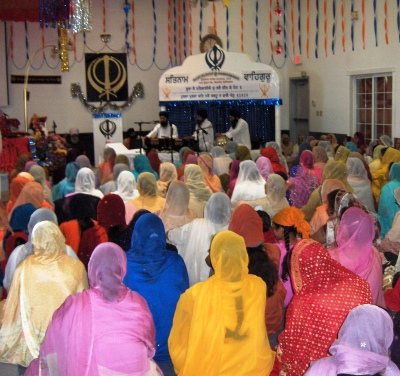 Phulkari’s post a few weeks back got me thinking about Gurdwaras – their origin and the role they play in Sikh society today. History tells us that Guru Nanak Patshah created Dharmshalas in Kartarpur where Sikhs would rise early and meet for Keertan, Veechar, reflection, and Guru-ka-Langar. It was a central element to the ideal society that Kartarpur would become.
Phulkari’s post a few weeks back got me thinking about Gurdwaras – their origin and the role they play in Sikh society today. History tells us that Guru Nanak Patshah created Dharmshalas in Kartarpur where Sikhs would rise early and meet for Keertan, Veechar, reflection, and Guru-ka-Langar. It was a central element to the ideal society that Kartarpur would become.
Over a century ago, Sikhs first arrived in North America – working at lumber mills, railroads, and as migrant laborers. They settled their families and chose to establish Gurdwaras (as early as 1908 in West Vancouver, BC and 1912 in Stockton, CA) to preserve both their spiritual and cultural roots in the land far from their history.
Now with hundreds of thousands of Sikhs in North America and the needs of our communities growing, the Gurdwara has expanded the services it offers far beyond its humble beginnings. Many Gurdwaras have Khalsa schools and libraries. Others plan for fitness centers, basketball courts, and healthcare clinics. One of the local Gurdwaras here hosts an annual Panjabi cultural show and mela, with weekly Giddha and Bhangra practices held at the Gurdwara facility itself. The North American Gurdwara has become not only a spiritual center, but also a community center, serving all the needs of the Sikh and Panjabi population.
On the one hand, I like having a Gurdwara as the center for our community’s activity. Although not all people have an initial interest in Sikhi, all these other events and programs at least keep people coming. And even a short “ritualistic” trip to the Gurdwara could develop in to something more. On the other hand, I can’t help but wonder…are we asking too much from our Gurdwaras?
With such different and competing interests, leaders fight for position so they can make their agenda the focus, and control Gurdwara resources accordingly. This drives much of the political drama and power struggles that surround our Gurdwaras today. As a result, many programs (such as Khalsa schools) end up mismanaged, poorly resourced, and inefficient.
Secondly, with all the programs our Gurdwaras offer, I question – are we taking away from the primary purpose of the Gurdwara…learning Gurmat (the Guru’s way)? How well do our Gurdwaras focus on Simran and Veechar? How well do our Gurdwaras connect the youth with the Guru’s message? What about services for non-Panjabi speakers or introducing non-Sikhs to our faith? What about programs emphasizing Sikh culture – like Gatka or Gurmat Sangeet? Are our Gurdwaras really institutions for learning? If the answer is less than perfect, shouldn’t we re-prioritize and change the focus of our Gurdwaras?
Many Gurdwaras serve small communities in rural areas where limited resources force the Gurdwara to serve multiple purposes. However, in larger communities, where resources are plenty – should we consider separating out our organizations? Maybe create separate Punjabi societies, Khalsa schools, clinics, and even Sikh community centers that focuses on outreach, youth counseling, and seva projects?
Perhaps under separate structures and management, these organizations will be able to thrive and meet their goals more efficiently with less resistance. And with our community’s growing needs, why not grow our presence with more diverse organizations?
Thoughts?
 As someone who considers herself honorary Peruvian (it’s a long story) – I was especially proud when I heard about Operation Walk – an organization established by Harpal Singh Khanuja and his wife Maria Khanuja. The non-profit organization is dedicated to providing free knee and hip replacements to underserved people around the world. The concept behind the organization was to perform complicated surgeries on people in developing countries, “where arthritis progresses to its end stages and reconstructing joints becomes technically challenging.” Often times, it is people who are most at need who cannot afford the surgery. A news article discusses Operation Walk’s recent trip to Lima, Peru where they performed 48 surgeries to replace knee and hip joints. Here on TLH we like to highlight examples of seva – this is another important example of what it means to do selfless service,
As someone who considers herself honorary Peruvian (it’s a long story) – I was especially proud when I heard about Operation Walk – an organization established by Harpal Singh Khanuja and his wife Maria Khanuja. The non-profit organization is dedicated to providing free knee and hip replacements to underserved people around the world. The concept behind the organization was to perform complicated surgeries on people in developing countries, “where arthritis progresses to its end stages and reconstructing joints becomes technically challenging.” Often times, it is people who are most at need who cannot afford the surgery. A news article discusses Operation Walk’s recent trip to Lima, Peru where they performed 48 surgeries to replace knee and hip joints. Here on TLH we like to highlight examples of seva – this is another important example of what it means to do selfless service,
“It was very rewarding to do this work for people and not expecting anything in return,” Harpal Singh said. “It’s really their gratitude that you cherish the most.”
The organization’s goal is to replicate the Peru mission to Panjab where the need is also great (some of which can be attributed to the chemical farming of the Green Revolution).
According to the Sikh Times, Sikh police officers are coming together to help address discrimination within the workforce in addition to addressing community relations between Sikhs and the British police.
The Association, which is to launch next Wednesday, lists its goals as follows:
The aims and objectives of the BPSA are;
- To establish a national forum for Sikh members of the British police services
- To assist the British police services in developing strategies to recruit, retain, and progress Sikh members of the service hence increasing Sikh representation in the police service at all levels
- To provide a religious, cultural and social forum for members of the BSPA through celebration of dates and festivals on the Sikh calendar.
- To promote an understanding of the Sikh Faith and the Sikh values of democracy, equality and justice within the police services
- To provide support and advice to Sikh members of the police service.
- To promote social cohesion and integration.
On TLH we have posted on the importance of Punjabi/Khalsa Schools. I have found that despite many students’ resistance to attend these schools, they plant the seeds for future exploration into Sikhi. At the age of 12 you may think you are too cool for school on Sundays, but at 19-20 or even 30 that experience creates a base for you to delve more deeply into your spiritual identity. Thus, I think it is extremely important that each Sikh community have at least one good Punjabi/Khalsa school. Ideally, I would want each Gurdwara to have one.
However, Punjabi/Khalsa Schools run into problems because in some way or another they become linked with communal politics. Most often this politics infiltrates schools within Gurdwaras. I think a fundamental component of a Gurdwara is a Punjabi/Khalsa School as is a Langar Hall. However, for many Gurdwaras, Punjabi/Khalsa Schools are a last priority. Gurdwara committees will fund new kitchen appliances before making a commitment to continually fund a Punjabi/Khalsa School. Thus, some community members have decided to create Punjabi/Khalsa Schools outside of the Gurdwara in local community-centers. When I hear this, I am both excited and disappointed. Excited that a school has been established; but disappointed that we are showing Sikh youth that we have to step outside of our main institution, the Gurdwara. How are we supposed to socialize our children into a Gurdwara-going culture when our leadership doesn’t support it in action? It’s a Catch 22. I don’t blame community members for creating schools outside of the Gurdwara. Their circumstances are real and, many times, this is their only feasible option. Or is it?
What exactly is the function of a Sikh Student Association? Is it simply to bring Sikh students together on campus for token meetings? Is it to celebrate Vaisakhi by organizing bhangra parties? Is it a platform to mobilize students to act upon issues impacting Sikh youth and the Sikh community? Is it… okay, I’ll stop with the questions.
To be quite honest, I don’t know the answers to these questions. I can speak to what I think the potential of such organizations is – what they could achieve and how an active and effective Sikh Student Organization could impact change. For example, here on TLH we’ve previously discussed how Sikh Student Associations in California have organized student initiated Kirtan and come together for Nagar Kirtans. Last week Camille discussed an initiative taken up by the University of Texas Sikh Student Association (the post stirred up some issues about the role of Sikh student associations). While these events are sporadic and intermittent – they are an example of one of the functional elements of a Sikh Student Organization – to educate ourselves and others about Sikhi.
However, it has to go beyond that. While I think any and all Sikh Student Associations should be given accolade for planning and participating in activities such as weekly Rehraas – there is much more to be achieved. Perhaps what’s integral to the success of these organizations (and to ensure they are effective) is to create an umbrella organization which provides resources and support to local Sikh Student Associations.
Take B.O.S.S. for example,
The British Organisation of Sikh Students is a non-political, non-profit making, independent body which acts as an umbrella organisation helping to develop, assist and support Sikh youth groups. [link]
If Baldev Mutta’s cellphone rings in the middle of a meeting, he picks it up. If it beeps over dinnertime or at midnight, he answers it. And if he has to go out to pick up a woman and find her a spot at a shelter at 3 a.m., he will do it. “It can mean the difference between life and death for a woman,” said Mutta, executive director of Punjabi Community Health Services in Brampton. “They are abused and don’t have anywhere else to go. This agency is their lifeline.” [link]
The Punjabi Community Health Services is an organization based in Brampton, Canada which provides various services to Punjabi women who have been abused. Instead of waiting for women to turn up at their doorstep, this organization takes a proactive approach by sending workers into the community to speak with abused women. They visit Gurdwaras and community centers to find women in distress. At times they must speak with the women secretly at doctor’s appointments, grocery stores, even parking lots, so their families don’t find out.
::
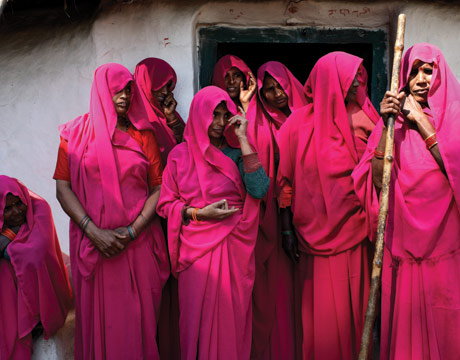 In related news, I recently read an article about the “Gulabi Gang” in an issue of Marie Claire which appeared on New America Media yesterday aswell. The Gulabi Gang are a group of women in India who have come together to fight against abuse. When local officials refused to take action against an alleged rapist, scores of pink-sari-clad women stormed the police station, demanding action – and thus, became know as the Gulabi Gang. For example, when Sampat Pal Devi learned that a friend had been beaten by her alcoholic husband and that the local police, chronically indifferent to violence against women, had looked the other way, something inside her snapped. In an effort to fight back, she gathered dozens of her female neighbors, armed them with sticks, and taught them how to fight back. Together, the self-declared Gulabi Gang have beaten up accused rapists, profligate officials, and husbands who’ve abandoned their wives.
In related news, I recently read an article about the “Gulabi Gang” in an issue of Marie Claire which appeared on New America Media yesterday aswell. The Gulabi Gang are a group of women in India who have come together to fight against abuse. When local officials refused to take action against an alleged rapist, scores of pink-sari-clad women stormed the police station, demanding action – and thus, became know as the Gulabi Gang. For example, when Sampat Pal Devi learned that a friend had been beaten by her alcoholic husband and that the local police, chronically indifferent to violence against women, had looked the other way, something inside her snapped. In an effort to fight back, she gathered dozens of her female neighbors, armed them with sticks, and taught them how to fight back. Together, the self-declared Gulabi Gang have beaten up accused rapists, profligate officials, and husbands who’ve abandoned their wives.
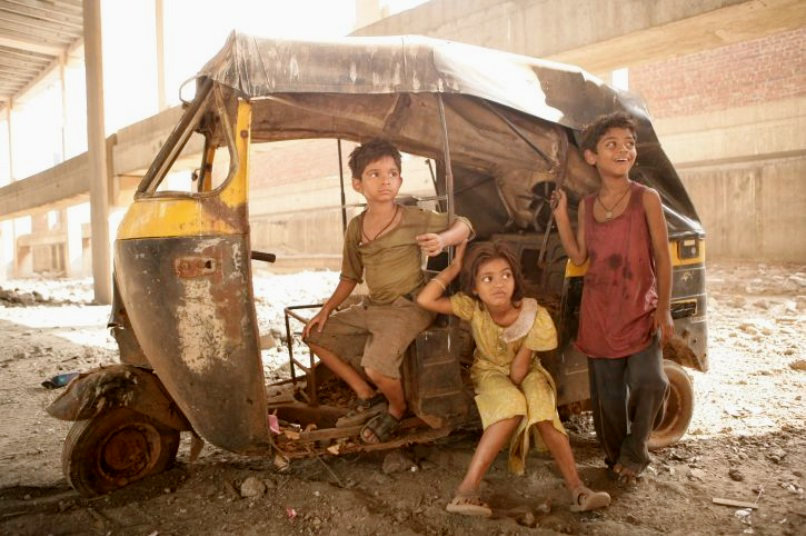 Amidst all the “Slumdog Millionaire” Oscar hysteria, some have been asking how are we ACTUALLY going to combat the issues of poverty in Indian slums? I heard on “Entertainment Tonight”, or some show like that, the movie’s directors/producers have set up a trust-fund for the child-stars (who currently live in slums), are paying for their families to move into decent apartments, and will be paying for the children’s education.
Amidst all the “Slumdog Millionaire” Oscar hysteria, some have been asking how are we ACTUALLY going to combat the issues of poverty in Indian slums? I heard on “Entertainment Tonight”, or some show like that, the movie’s directors/producers have set up a trust-fund for the child-stars (who currently live in slums), are paying for their families to move into decent apartments, and will be paying for the children’s education.
But how about the rest of the families who were cheering away in Mumbai slums as “Slumdog Millionaire” won its eight Oscars? I came across this great blog post by Minal Hajratwala, “Slumdog”: Don’t Just Watch, Do Something, which took scenes from the movie and talked about how we can address those poverty issues in reality. I am going to copy a few of those segments here, but please do visit Minal’s blog for the full-effect.
I. Introduction
My last post, which addressed the First Global Sikh Civil Rights Conference held by the non-profit group United Sikhs, generated significant discussion. In an attempt to re-focus and reinvigorate that discussion, I wish to first clarify what the post was not about — it was not intended to serve as an indictment of the United Sikhs’ work overall, to criticize specific projects or initiatives other than the conference, or to compare their efforts to that of other Sikh organizations with greater financial resources. Some of the comments did touch on these subjects, though this was not my intention.
My sole interest was and remains the manner in which the United Sikhs decided, on its own, to describe the conference and the report to the public, including necessarily the Sikh members of it. I wrote that it was “the United Sikhs’ characterizations of the conference and report” that I found problematic. Regrettably, the comments to my post — some made spiritedly by United Sikhs Director Mejindarpaul Kaur and others working for or affiliated with the United Sikhs — have done little to assuage my earlier concerns.
 To my surprise, I came across a news article with the headline, “Sikhs Agree on a Global Civil Rights Agenda.” When did we do that??
To my surprise, I came across a news article with the headline, “Sikhs Agree on a Global Civil Rights Agenda.” When did we do that??
It turns out that the United Sikhs — a non-profit organization that addresses various civil rights issues on behalf of Sikhs, especially and including the French ban on conspicuous articles of faith — issued a press release indicating that the group held the First Global Sikh Civil Rights Conference at which the First Global Sikh Civil Rights Report was presented and adopted.
At the outset, I should note that I respect the United Sikhs’ work, most notably its humanitarian efforts. I also appreciate its interest in developing a set of broad Sikh civil rights issues and recommendations on how to tackle those very issues. The Report itself contains a wealth of information on the Sikh experience in many different countries, most of which are often overlooked in discussions of the Sikh diaspora. The breadth of the report is impressive; a lot of effort seems to have been put into its publication.
That said, the United Sikhs’ characterizations of the conference and report are troublesome in at least several respects — its factually inaccurate, grossly misleading, and plainly self-serving.
A new contest + award is in place for Sikhs. Who will be the Chic Sikh of the Year for 2008?
The sponsor is Sikhchic, the online magazine which promotes Sikhs in the arts (and also invites articles on an array of subjects). The nomination process is completely transparent, which make s it interesting. Anyone can nominate by simply entering a nomination and the reasons for it as a comment. It then gets posted, so you can see all of the nominations here. So far, the illustrious nominees include: Prime Minister Manmohan Singh, the Singh Twins, Fauja Singh, Amandeep Singh Madra, and I.J. Singh.
s it interesting. Anyone can nominate by simply entering a nomination and the reasons for it as a comment. It then gets posted, so you can see all of the nominations here. So far, the illustrious nominees include: Prime Minister Manmohan Singh, the Singh Twins, Fauja Singh, Amandeep Singh Madra, and I.J. Singh.
The award doesn’t have to be awarded to a Sikh. It’s unclear how much of a connection a nominee has to have to the Sikh community- whether they have to commit a Sikh-like deed or act to somehow promote/improve the Sikh community. It also doesn’t have to be to a person- it can be to an institution. There are many organizations that have done some really interesting things in the past few years for the Sikh community, and I’m sure we’ll be seeing some of them nominated.
Awards validate ideals- confirm that they mean something. It ‘s unclear so far what ideals this award will recognize since the parameters for nomination have been left purposefully vague. I guess we’ll know more when an awardee is chosen.
As an UPDATE to my post a couple weeks ago, the Sikh Coalition has released the “2008 Presidential Elections Voter Guide For Sikh Americans”. P.S. McCain never responded … the guide contains some of his answers collected from outside resources (the Coalition became our #1 research assistant)!
According to the Sikh Coalition:
Our candidate questionnaire was provided to both the major party candidates in November 2007. Since then, the Sikh Coalition has provided all candidates multiple and repeated opportunities to answer its questionnaire. Our Voter Guide reflects the answers of the candidates who responded to our questionnaire.
The Sikh Coalition’s Sikh American Voter Guide includes information about how and where to vote on Election Day, summaries of proposed laws that affect Sikh interests, and the presidential candidates’ answers to our questionnaire. Of the 13 candidates running for president of the United States, a total of five responded to the Coalition’s questionnaire – including one of the two major party candidates.
The 25-page guide-book has a brief biographical section on all 13 candidates running for President, along with pictures (Prabhu Singh Khasla … Ralph Nader is represented)! In addition, responses from the candidates on questions addressing:
1) Relationship With Sikhs
2) Hate Crimes
3) Religious Profiling
4) Employment Discrimination
5) Discrimination
6) Asylum
7) Immigration
Check it out! Let’s us know what you think! Make copies and get them out to your sangats at local Gurdwaras before next Tuesday!
Vote On Tuesday (11/04/2008)! You can find your local polling place through Google here!

For the uninitiated Panthic Weekly is a Sikh portal that provides news and media on various issues that affect the Sikh community. As part of the Panthic Network, my first memories of the team are related to the long-standing Fort Panth Khalsa that especially became popular during the debates centered around the then-Jathedar Ranjit Singh.
The website over the years has developed a formidable presence on the website and is a celebrated by that section of our community that have a leaning towards the strong opinionated slant it represents, especially towards a specific Jathabandi.
For the most part, I applaud Panthic Weekly’s efforts and their abilities to engage with youth audiences with a variety of media. Their Khalsa.tv, Panthic.fm, Kathaa.net and Keertan.net are all efforts that deserve praise.
However, my problem with the network is their derogatory language and uncivil discussions that are promoted, often bordering on bullyism. Whenever, the editors of Panthic Weekly do not like a person, they change their name from ‘Singh’ to ‘Sinh’. Parkash Singh Badal becomes Parkash Sinh Badal; Former Jathedar Darshan Singh Ragi becomes Darshan Sinh Ragi; Prime Minister Manmohan Singh becomes Manmohan Sinh. Allegations of RAW agent, RSS-stooge, “traitor”, etc. and the worst parts of our post-1984 history are relived where Sikhs spew vitriole on other Sikhs.
Recently on TLH we have had many posts around the 2008 Presidential Campaign. How these candidate make us feel and their policy positions are equally important when deciding, which candidate to support. The qualities and values he brings to the table for organizing support around what he thinks are critical issues is important for identifying which man will make the best key leader in America. We have listened to them debate, create campaign ads, and talk on campaign trails to their supporters. At the end of the day, I personally want to know how McCain and Obama will stand on issues important to me as a Sikh. The  economy, healthcare, foreign policy, and civil rights are important to all Americans regardless of ethnic or religious background; however, the nuances of how each ethnic/religious community is effected by these larger issues is important when their members vote for a Presidential Candidate. Many Sikhs may want to know:
economy, healthcare, foreign policy, and civil rights are important to all Americans regardless of ethnic or religious background; however, the nuances of how each ethnic/religious community is effected by these larger issues is important when their members vote for a Presidential Candidate. Many Sikhs may want to know:
“What is John McCain’s stance on racial profiling? How would an Obama administration address workplace religious discrimination?”
In an effort to answer some of these questions, the Sikh Coalition sent questionnaires to both McCain and Obama campaign offices many months ago. The intention was to have this information available when organizing Sikhs to vote at local Gurdwaras. However, only the Obama campaign responded. In an effort to provide bi-partisan information to the Sikh constituency, the Sikh Coalition is now petitioning McCain to respond, particularly when there are less than 30-days left until election-day. Sikhs deserve to hear his voice when making their decision at the ballot box. In addition, as a non-profit organization, the Sikh Coalition can not solely release Obama’s responses.
Often on this blog we have discussed what role our institutions should play in our lives and recently I had an opportunity to examine the issue anew. In a recent gurdwara council meeting I attended, one gurdwara decided to give a large sum of money to a group putting on a bhangra program. The group was not affiliated with the gurdwara. I will admit, I did not say anything at the time because I do not attend the gurdwara that decided to do this, but the incident did get me thinking about gurdwara funds and the concept of daswand.
When a gurdwara collects funds from the sangat – it does so under the pretence that the money is being collected to be put to some higher use, a use that we ourselves could perhaps not put it to, whether it be spiritual or practical. Usually we give the money as part of our daswand or some random seva to the gurdwara, but I think in every case it is understood that we are giving the money up to be put to a use that our Guru’s would have used it for – something necessary, something practical, and fundamentally “good.”
And as I write this post, some questions that I haven’t even answered for myself come to mind – Is the daswand I give to the gurdwara something I have a right to control – can I decide where it goes? If Sikhi is to be treated like a democracy, I would argue that absolutely I have every right to “vote” on where the funds go or at least have a chance to say something. But even in such a vote – should there be limits? Shouldn’t the funds of a gurdwara be spent on activities, which embody Sikh ideals and values? Presently, I am inclined to believe that sangat should have a say in where gurdwara funds are spent, but also that the options for spending funds should be limited to projects that actually embody and promote Sikh ideals.
But back to where we started – I brought bhangra up because it is something that can be debated – I’m not contending that it is an anti-Sikh activity, but at the same time, I don’t really think bhangra is something that perpetuates the Sikh way of life either. So I guess the dilemma in my mind in determining where the gurdwara should be spending its funds and where to draw the line…
Update: wow, I did an AWFUL job of summarizing SRI’s first webinar. (Apologies to the good folks at SRI) Here’s a better summary:
Sikh Theology – A Gurmat Framework: The first session comprised of introducing an approach to Sikhi and recognizing how Guru Nanak Sahib revolutionarily delivered a message of Oneness through illustrating a direct connection between ideas and practice. We engaged in understanding what ‘Guru’ means in the Sikh context and how we can begin to comprehend the Guru’s wisdom, Gurmat. To develop this understanding, three facets of bani (scripture), tavarikh (history) and rahit (lifestyle) were introduced. The greatness of a religion is when harmonious balance between Ultimate reality and visible form is exemplified thru the aforesaid facets. We concluded with Puran Singh’s rendering on the Guru’s vision, “It sweetens you and your sweetness sweetens all life around. At your sight, the lamb and the tiger must drink at the same pool.”
And some info on session 2:
Bani – The Message: In session two, we continued to build on our understanding of the Guru’s message; We engaged in actively learning about the scriptural canon, the Guru Granth Sahib. In covering topics as the compilation, contributors, structure, language and content of Guru Granth Sahib, we tackled questions such as, “How do we know Guru Granth Sahib is the Guru?” and “What is the Sabad Guru?”; thus, facilitating and inspiring us to continue to build our personal relationship with Guru Granth Sahib.
And 3:
Tavarikh – The Revolution: Having concentrated on the written form of our Guru’s message (Bani) last week, this week in session three, “Tavarikh – The Revolution”, we will turn our focus on to how our Gurus exemplified The Message. We will walk through the lives of Guru Nanak Sahib through Guru Gobind Singh Sahib and try to understand them through a social, political, economic and spiritual framework. We will cover a range of issues, from touching on the ramifications of negating the need of a Divine intermediary, to the economic center created by the Guru Sahibs, to the activism of both social and political kind. In surveying the inspiring history of our Gurus, we hope to remind ourselves of how relevant, active and exemplary the revolution of Sikh? is.
In the past, several posts have focused on the work of the Sikh Coalition around community mobilization to fight school bullying and the launch of an educational tool. 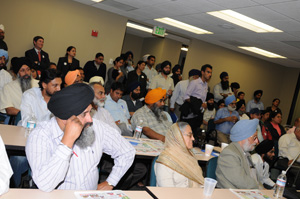 As part of the Sikh Coalition’s on-going work, it has opened a new office in Northern California to provide coast–to-coast civil/human rights advocacy for Sikhs. On September 10th, over 100 attendees, including local community members and politicians, celebrated the Sikh Coalition’s office opening in Fremont, California.
As part of the Sikh Coalition’s on-going work, it has opened a new office in Northern California to provide coast–to-coast civil/human rights advocacy for Sikhs. On September 10th, over 100 attendees, including local community members and politicians, celebrated the Sikh Coalition’s office opening in Fremont, California.
The Coalition’s, Western Regional Director, Neha Singh, said:
“Fremont is nationally the heart of the Sikh community … since we started, we’ve always taken cases from around the country, and a large amount of them were from the Bay Area. We thought it was now time to open an office in an area where a lot of the people requesting our services were.”
This past week, I saw this advertisement about the “GurSikh Speed Meeting.” For those of you who have no idea the Sikhnet’s Gursikh Speed Meeting is obviously (and admittedly) the Sikh version of speed dating. According to the organizers of the program: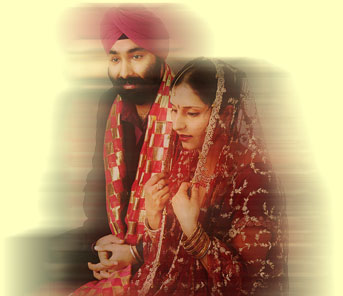
The concept is quite simple. An equal number of Sardars and Sardarnis register. On the event date, each Sardar will meet each Sardarni one-on-one and chat for a specified number of minutes rotating till they have met all the Singhnis. This face to face style of meeting has spurred much interest, in addition to, respecting the participant’s privacy. Only if there is an agreed ‘CLICK’ will an exchange of contact information occur.
I remember when I first saw Sikhnet advertising this a couple of years ago and thinking to myself, “this is bold.” I don’t necessarily think dating for Sikhs is anti-gurmat, but dating is definitely still taboo in A LOT of Punjabi Sikh families.
Young Sikhs are extremely internet savvy. From the proliferation of videos on youtube to remixed dhadhi-jatha to an embrace of web 2.0, many young Sikhs are at the forefront of creating new avenues for education about their faith. While I personally believe that most Sikhs focus their attention on education for non-Sikhs, in my opinion, far more crucial is the intra-Sikh education.
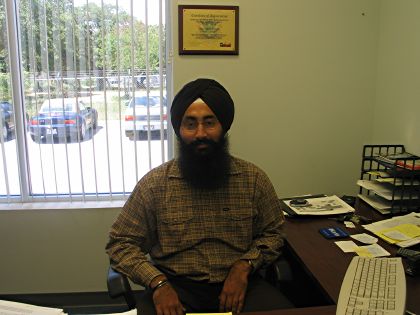 While in an earlier discussion I talked about the importance of the KhalsaKids website, launched last year by the Sikh Coalition. It is an example of Sikhs experimenting with new media forms to better address the needs and concerns of their community.
While in an earlier discussion I talked about the importance of the KhalsaKids website, launched last year by the Sikh Coalition. It is an example of Sikhs experimenting with new media forms to better address the needs and concerns of their community.
In a similar vein, the Sikh Research Institute has recently announced its plans for a “webinar” series, titled “Liv.”
Explaining the impulse of this new project, SikhRI head, Harinder Singh, states:
“We are regularly in touch with Sikh communities in North America, Europe and Asia who want us to deliver programs in their local communities on a regular basis, but it’s been quite difficult due to logistical and financial constraints. Now that we are introducing webinar facilities, our programs can reach anyone around the globe and we look forward to being able to engage with the vast Sikh communities outside of our traditional target area in North America”[link]
The “Liv” project entails four 90 minute seminars to begin at 8am PST (California time) on 4 consecutive Saturdays, beginning September 13, 2008. The first four topics listed on their website includes: “Sikhi – A Gurmat Framework,” “Bani – The Idea,” “Tavarikh (History) – The Revolution,” and “Rahit – The Lifestyle.”
A pre-registration is required to participate in the “webinar” and can be completed here.
While waking up at 8am on Saturdays is beyond my abilities, the seminars being conducted by The Harinder Singh sound intriguing and informative. I hope some of our readers can that do participate can discuss some of their thoughts on the format and the content here.
Also what are new ways that you have seen Sikhs embracing Web 2.0? (yes I am already aware of that one blog, uhhh but I can’t think of the name.)
In a recent post, Camille asked important questions around growing Sikh female leadership/representation, rather than just “managing” it. At the heart of leadership in any organization is decision-making. A critical component of growing Sikh female-leadership/representation is giving access to decision-making spaces that are commonly occupied by Sikh men and incorporating female perspectives into decision-making. Thus, you will see the strongest battles for gender equity in Sikh organizations tend to be fought around decision-making power. A recent example of such a battle was at a Gurdwara in Bristol, U.K. where two factions were fighting over allowing women to take part in Gurdwara elections. Women were demanding the right to vote while also running for committee-member seats. This past Sunday during Gurdwara management-committee elections, both factions broke out into a riot over allowing 79 women to vote past the registration deadline.
According to the Daily Mail:
Six riot vans were dispatched to close the road in Fishponds, Bristol, and one man was arrested and cautioned for a public order offence during the seven-hour stand-off.
Voting finally finished at 4pm and resulted in three women being voted onto the management committee for the first time in the temple’s history.
The trigger for the riot was when one man frustrated by the situation started trouble inside the Gurdwara that spilled out onto the street where “women were blocking his car and trying to push it over while he was still inside clinging to the steering wheel”.
An elderly women at the site reported “… a crowd of mainly women and children stood on one side of the road and men on the other. They were fronting each other up and shouting abuse across the road. The women were screaming ‘we’re not going anywhere’.
